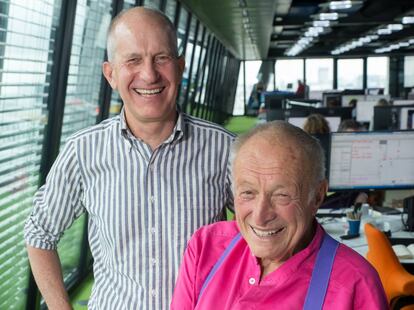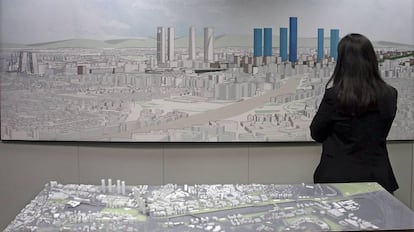¡°The Castellana Norte project will tell the world that Madrid is back¡±
UK architects Richard Rogers and Simon Smithson discuss their plans to revive north of Spanish capital

On the 14th floor of London¡¯s Leadenhall building ¨C a skyscraper popularly known as The Cheesegrater ¨C British architect Richard Rogers and his team are putting a lot of thought into how to transform the skyline of the Spanish capital.

His firm, Rogers Stirk Harbour+Partners, has been tasked with the Distrito Castellana Norte megaproject, which ¨C after several false starts dating back more than a decade ¨C is back on track, and which aims to transform a huge swathe of the northern edge of the city around Chamart¨ªn railway station. The idea is to establish a new business district able to attract foreign investment while at the same time creating a neighborhood that captures the spirit of the capital and provides a gateway to the mountains barely 50 kilometers away. Rogers¡¯ partner Simon Smithson knows the capital well, having lived here for a decade while he worked on the T-4 extension to Barajas airport.
Question. What can Madrid residents expect from this project?
Simon Smithson. The first thing is to reclaim the area, which is a huge hole in the city that needs repairing. It¡¯s a lost area and one that dramatically affects connectivity in the north of the capital. Then there is the question of [using Chamart¨ªn for] AVE high-speed trains. Atocha train station is overstretched and there is no room for more trains. At the same time, Spain is emerging from a difficult time. This is an important project to tell the world: Madrid is back.

Richard Rogers. The area around Chamart¨ªn has not been well maintained, but has the potential to be the heart of the city. Cities have skeletons, a heart, a brain and hands. This project will reflect the latest transport trends. There are needs that are aligning that didn¡¯t exist before: Chamart¨ªn needs to be sorted out, the city needs to show that it aspires to be a major European capital, and the north of Madrid has connection problems that need to be resolved.
Q. Traveling up the Castellana [the capital¡¯s main avenue] from south to north is a journey through Madrid¡¯s history. What role will it play in the project?
S.S. True, it¡¯s amazing: the Castellana tells the history of this country¡¯s development. This is the root of our analysis. The first stretch was a place to walk, to promenade, on the edge of the city. Then it extended to the [upmarket] Salamanca neighborhood, [the government area of] Nuevos Ministerios, Azca [a mixed-use Madrid business district close to the Castellana], the four [skyscraper] towers¡ each stretch of the Castellana represents the values of an age. This section should return it to its origins. There is something marvelous about the idea of the promenade in Spanish culture. For the Castellana to return to being a place to walk is a lovely idea.
Our vision is a green network that stretches all the way from the mountains almost to the city Simon Smithson, architect
Q. You are both proponents of compact cities.
R. R. Cities should be compact. A dense city uses half the amount of energy. Vertical is more sustainable, it is more efficient to use a lift than a car. I argue that we should build new villages within cities, not outside them. Sustainability means developing new centers.
Q. How do you keep a business district alive outside office hours?
R. R. This is the biggest challenge and the most interesting part of the project. We don¡¯t want to create ghettos and it is important to create mixed-use areas. It isn¡¯t just about proportions between different uses, but also about the dynamics you create. Cities are chemical equations.
S. S. Azca, for example, has mixed use, but is a desert and doesn¡¯t work. There is something particular about the character of Madrid, that mix of work and pleasure that gives character to its streets. Quality of life has to be a factor. We would like to create a business district that says something about living in Madrid. For an international company looking for a place to locate, Madrid has to offer what other capitals offer and then something of its own.

Q. The idea is for six large skyscrapers. Is that right?
S. S. It¡¯s not a done deal. Tall buildings will be important, but the most important thing is to create a vibrant business district with mixed use.
Q. Construction in Madrid is still associated with speculation and corruption. How can that be combated?
S. S. The idea of viewing projects as property development hasn¡¯t worked. But there is another way, which is to build the city, and that isn¡¯t the same as property development. It goes way beyond a simple numbers game. Making a good city is good for everybody, including developers.
Q. Aside from the international aspect, this is about the type of city Madrid should be for the people who live there.
We don¡¯t want to create ghettos and it is important to create mixed use areas Richard Rogers, architect
S. S. The main thing is the ability of Madrile?os to use and bring life the streets, but the right spaces need to be there. Las Tablas, Sanchinarro [neighborhoods in the north of the city created over the last two decades] have been successful in providing housing for young families, and they work well at that level, but they don¡¯t work as cities. We have to create a business district that says something about Madrid. We have to create spaces that invite people to live in them, in the way that the people of Madrid do so well.
Q. What will the green areas be like?
S. S. Returning to the wonders of the place, the Pardo [protected parkland to the northwest of the city] is on the doorstep. You¡¯ve got wild boar five kilometers from the center of Madrid! There is a nature reserve that at the moment is difficult to access, it would be wonderful to open it up. Our vision is a green network that starts in the new national park in the mountains and that would be directed to the city, bringing it almost into the center, bringing the mountains.
?English version by Nick Lyne.
Tu suscripci¨®n se est¨¢ usando en otro dispositivo
?Quieres a?adir otro usuario a tu suscripci¨®n?
Si contin¨²as leyendo en este dispositivo, no se podr¨¢ leer en el otro.
FlechaTu suscripci¨®n se est¨¢ usando en otro dispositivo y solo puedes acceder a EL PA?S desde un dispositivo a la vez.
Si quieres compartir tu cuenta, cambia tu suscripci¨®n a la modalidad Premium, as¨ª podr¨¢s a?adir otro usuario. Cada uno acceder¨¢ con su propia cuenta de email, lo que os permitir¨¢ personalizar vuestra experiencia en EL PA?S.
En el caso de no saber qui¨¦n est¨¢ usando tu cuenta, te recomendamos cambiar tu contrase?a aqu¨ª.
Si decides continuar compartiendo tu cuenta, este mensaje se mostrar¨¢ en tu dispositivo y en el de la otra persona que est¨¢ usando tu cuenta de forma indefinida, afectando a tu experiencia de lectura. Puedes consultar aqu¨ª los t¨¦rminos y condiciones de la suscripci¨®n digital.










































